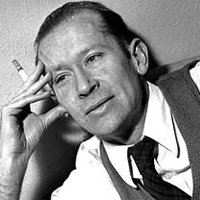i sing of Olaf glad and big by Edward Estlin Cummings: Summary and Critical Analysis
The poem 'i sing of Olaf glad and big' by Cummings is a typical poem based on Cummings's experience in the army. It is an ironic retelling of the torture and death of a conscientious objector during World War I. The character Olaf in the poem was a soldier in another barrack when Cummings was also a soldier in France. One day two had met for some time and while talking, the other soldier had talked very bitterly against the vulgarity and immorality of wars in general.

E. E. Cummings (1894-1962)
His point, very much like Cummings’s was that true courage lies in morally winning the evil and not in killing men with bullets. But unfortunately, the other soldier was found talking against the war by the captain, who at once took him into custody and let a whole horde of soldiers, beat him.
The man was beaten until his body was severely damaged, but he still replied with the bitterest scorn for the tormentors and war that he would not surrender; war was vulgar, cowardly and disgusting. The case sent as high as the American president, who gave orders to imprison the soldier. Olaf probably died soon in the prison. This poem is a tribute to the friend Cummings paid after he left the army himself. The poem narrates the story of the torture and the speaker praises the brave man in unconventionally bright terms.
This poem grew out of Cummings personal experiences at Camp Devens, Massachusetts, shortly after he was drafted into the Army in July of 1918. This poem is based on his brief acquaintance with one soldier who shared his disgust for violence. After a conformation with the commanding officer, Olaf was seen no more, but rumor persisted that he had been transferred to the Army prison to be brutalized for this pacifistic stance. Olaf, as both “glad and big” seems to embody the characteristics most prized by Americans. Olaf’s anti-war stance leads to violence as he is taken soon in hand by his colonel and is then beaten by a “host of overjoyed noncoms”, who resemble cruel children in a schoolyard. To this treatment Olaf responds with an understated but firm resistance: “without getting annoyed/ ‘I will not kiss your fucking flag’ ”. Army officers are “yearning nations” blue-eyed pride” but immediately the poet depicts them in the worst possible light kicking and cursing a friend. This violence continues until, “their clarion/ voices and boots were much the worse.” Olaf is sodomized by a bayonet “roasted hot with heat.” Olaf maintains his dignity. He sits on “what were once knees.” The poem ends with a kind of benediction; the narrator involves “Christ (of His mercy infinite)” and prays that Olaf will see him. Olaf was “braver than me: blonder than you.” Olaf cannot be classified as passive, since he combats his ignoble humility with brutal obscenities and invectives that his tormentors will understand. The poem offers an alternative to violence: the heroic value of moral strength. This strength allows Olaf to achieve epic stature even when he tortures by to strip him the last vestige of human dignity.
The poem is also remarkable for the technical (stylistic) features. Some of the techniques include pun, paradox, and inversion of cliché, grammatical turning and typographical experiments. The purpose of these techniques is their immediacy of effect. In this poem Cummings avoids traditional capitalization. The narrative “i” in lower case indicates his own humility, while the importance of Olaf is indicated by the fact that each “i” referring to him is capitalized. Wards are broken into component parts, “objector” to draw attention to his message suggesting that Olaf is merely an object, manipulated by society to meet its own ends. Typographically, he removes spacing to increase speed and indicate mood: “first-class-privates”, “yellowsonofabitch,” etc. Several puns appear in this poem including “grave”. Cummings unusual use of punctuation allows him to control when his readers pause and how long they meditate on a certain idea. Yet despite these non-conformist features, the poem utilizes a traditional rhythm (iambic tetrameter) and a traditional rhyme scheme. Cummings thus combines experimentation with traditionalism, exploring new uses of typography, syntax, ellipses, and visual arrangements while retaining relatively normal rhythm and rhythm.
Cite this Page!
Sharma, K.N. "i sing of Olaf glad and big by Edward Estlin Cummings: Summary and Critical Analysis." BachelorandMaster, 4 Nov. 2013, bachelorandmaster.com/britishandamericanpoetry/i-sing-of-olaf-glad-and-big.html.
